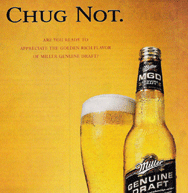After month’s of discussion about improving beer’s image, brewing giant Anheuser-Busch will put its money where its mouth is. The St. Louis Post-Dispatch reports the brewer will provide one of its coveted Super Bowl spots for an ad promoting the industry.
“It wasn’t too difficult of a decision because everyone in our company realizes the need for Anheuser-Busch to lead an industry platform,” said Bob Lachky, executive vice president of global industry development at A-B’s domestic brewing unit.
The spot, dubbed “Slainte,” in reference to a Gaelic toast, will air during the fourth quarter of the Super Bowl, in which 30 seconds of ad time sells for about $2.5 million.
“It starts to send a different signal about the demographics of beer,” Lachky said. “It starts to paint a slightly different picture than what people might come to expect (from beer), and it totally puts a different face on beer.”
Beer Therapy will comment Monday after seeing the spot, and surely add some comments of our own about beer’s image.
A-B certainly isn’t overlooking any possible new ways to reach potential consumers. The company will make its Super Bowl ads available for postgame downloading at Budweiser.com. The beer giant worked with Maven Networks of Massachusetts to create an application that allows consumers to download their favorite beer commercials and watch them on video iPods, laptops, and computer screens.
The “Slainte” spot will also promote a new website, www.herestobeer.com, that goes live on Sunday. It features sections that educate consumers about the brewing process and offers food-pairing suggestions, historical facts, recipes using beer and “beertails,” suggested ways to mix beers.
The importance of the campaign became more apparent on Wednesday when A-B announced the impact of flat sales and higher costs in the fourth quarter, with profits plunging almost 40% from a year ago.
A-B’s problems reflect those of all the largest brewers. Overall beer sales were flat in 2005, although early reports indicate the craft segment grew at about a 7% pace.
 Miller Brewing has already told distributors about its plans revive the flagging Miller Genuine Draft brand by targeting young adults in their 20s and 30s. The campaign goes national March 1, with a “bridge” advertisements already launched. Miller’s advertisements – featuring the catch phrase, “Beer. Grown Up.†– are aimed at those in their late 20s to 30s who have drifted away from mainstream beers and switched to other alcohol-based drinks, or even craft beers or imports.
Miller Brewing has already told distributors about its plans revive the flagging Miller Genuine Draft brand by targeting young adults in their 20s and 30s. The campaign goes national March 1, with a “bridge” advertisements already launched. Miller’s advertisements – featuring the catch phrase, “Beer. Grown Up.†– are aimed at those in their late 20s to 30s who have drifted away from mainstream beers and switched to other alcohol-based drinks, or even craft beers or imports.
“We’ve found our target consumer, 26- to 40-year-old strivers that are being neglected by the beer category,” brand director Terry Haley said in introducing the campaign. “It is perfect for Miller Genuine Draft.”

 Miller Brewing has already told distributors about its plans revive the flagging Miller Genuine Draft brand by targeting young adults in their 20s and 30s. The campaign goes national March 1, with a “bridge” advertisements already launched. Miller’s advertisements – featuring the catch phrase, “Beer. Grown Up.†– are aimed at those in their late 20s to 30s who have drifted away from mainstream beers and switched to other alcohol-based drinks, or even craft beers or imports.
Miller Brewing has already told distributors about its plans revive the flagging Miller Genuine Draft brand by targeting young adults in their 20s and 30s. The campaign goes national March 1, with a “bridge” advertisements already launched. Miller’s advertisements – featuring the catch phrase, “Beer. Grown Up.†– are aimed at those in their late 20s to 30s who have drifted away from mainstream beers and switched to other alcohol-based drinks, or even craft beers or imports.